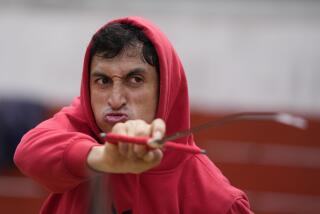At This Sale It’s All Bull, No Baloney
- Share via
RED BLUFF, Calif. — About 5,000 ranchers and cowboys from all over the West converged on this Northern California cow town, trucking their prize stock to the 47th annual Red Bluff Bull Sale, a five-day business confab and social gathering that ended Sunday.
“It’s more than a bull sale,” said John Ross of the 3,300-member California Cattlemen’s Assn. “It’s the biggest social event of the year for California cattlemen.”
Besides the action in the auction ring, there was the Bullshippers Banquet and Ball, a barbecue beef dinner and Western dance, several other dinner-dances, cowboy breakfasts and lunches.
GLC Firecracker, the grand champion 1,950-pound Brangus bull owned by the Granada Brangus Ranch in Davis, brought the highest price paid for the bulls in the sale--$5,450 paid by Tranquility Ranch of Corning, Calif.
The average price paid for bulls at the sale was $1,887--$201 more per animal than was paid at last year’s sale.
‘Sale Is a Barometer’
“People . . . see the strengthening of consumer demand,” Ross said. “This sale is a barometer of what’s going on with cattle prices.”
Last year was the first year cattle ranchers had turned a profit since 1981, and the years in between were lean; many ranchers went bankrupt.
“The commercial cattle market is up where we can finally make a living at it again,” said Merril West, 32, who trucked five Polled (hornless) Hereford bulls about 750 miles from his spread in Spanish Fork, Utah.
The sale of bulls, paint and quarter horses and cow dogs is an institution in Red Bluff (pop. 11,000), the county seat of Tehama County, where ranching has been the biggest industry since the 1850s.
There were 17 breeds among the 400 bulls at the sale, including Angus, Brangus, Hereford, Limousin, Santa Gertrudis, Shorthorn and Simmental. They came from ranches with names such as Cut N’ Chew, Lazy Mornin, Rogue River, Katie McNeil, Flying R, Rainbow’s End and Scattered Oaks.
Breeding stock owners paid $40 a head to enter a bull in the sale and 6% commission on sale. Only 282 of the 400 bulls were auctioned. The other 118 were examined and disqualified in “Heartbreak Alley” because they did not meet sale standards.
“The Red Bluff Bull Sale is always a learning experience,” said Barbara Jean Potter, 60, of Clements, Calif., who brought Diamond Disco, a Polled Hereford bull, to the sale.
Potter, a UC Berkeley English major who has ranched for 40 years, had high hopes for Diamond Disco, but he cut a hoof in a dressing stand as she prepared him for judging and was eliminated.
“It cost me about $500 to make the trip,” Potter said. “That’s the breaks.”
Owners of bulls accepted for the sale spend hours grooming their animals before they enter the auction ring.
“We comb their hair up sideways to give them a massive appearance. We clip and shape them so they look structurally correct and sound,” explained Kristin O’Reilly, 27, of Bar Nothing Ranch in San Luis Obispo.
‘I Fluff Up His Hair’
Ann Hansen, 25, of Rainbow Ranch in Lakeport, Calif., used a giant blow dryer on her Angus and then used spray adhesive to hold the bull’s hair in place. “I fluff his hair up just like I do mine to make him look good,” she said.
Wayne Pugh, 54, of Smith, Nev., started off Saturday’s auction leading MNC Outlaw, his grand champion Polled Hereford, into the ring. He hoped that he would get at least $5,000. When the staccato chanting of auctioneer Bill Lefty ended, the highest bid was $4,000.
Next came 65-year-old Keith Jenkins with his grand champion Hereford, Big Domino, which brought $4,000. Don Cardey’s grand champion Shorthorn, Revelation, was sold for $2,100. Kristin O’Reilly’s grand champion black Angus Casino, Big Sky, went for $3,000. The bulls will become breeding replacements used by ranchers to strengthen the blood lines of their range herds.
The Red Bluff sale was started by the late Don Smith, the University of California livestock adviser for Tehama County who got together with local ranchers in 1942 to hold the bull sale, hoping to attract stock from other areas of the West to improve local herds. The sale is now said to be the biggest annual sale of quality bulls in the country.
More to Read
Sign up for Essential California
The most important California stories and recommendations in your inbox every morning.
You may occasionally receive promotional content from the Los Angeles Times.













